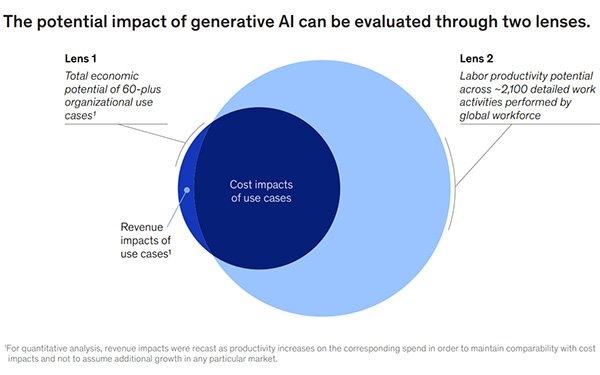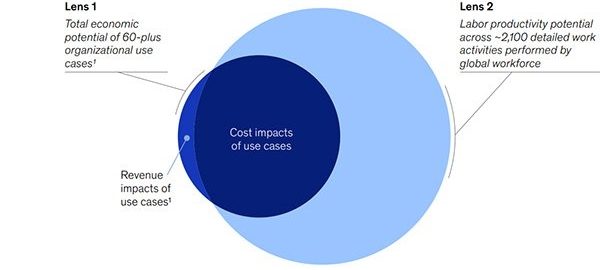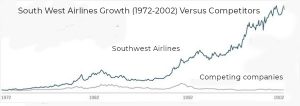McKinsey Analyzes Economic Impact Of Generative AI

The impact of generative artificial intelligence (GAI) on productivity could add trillions of dollars to the global economy, according to data released this week from McKinsey & Company.
The latest estimates put the equivalent of $2.6 trillion to $4.4 trillion annually across the 63 use cases McKinsey analyzed, according to the report–The economic potential of generative AI The next productivity frontier–published in June.
By comparison, the United Kingdom’s entire gross domestic product (GDP) in 2021 was $3.1 trillion. The estimate would roughly double if the data included the impact of embedding GAI into software being used for tasks beyond those studies.
McKinsey notes that banking, high tech, and life sciences are among the industries that could see the biggest impact from GAI in terms of a percentage of revenue.
In the banking industry, the technology could deliver value equal to an additional $200 billion to $340 billion annually. In retail and consumer packaged goods, the potential impact is between $400 billion and $660 billion a year
The timeline for change has been accelerated. OpenAI released ChatGPT in November 2022. Four months later, the company released a new large language model (LLM) called GPT-4 with improved capabilities.
By May 2023, Anthropic’s generative AI, Claude, could process 100,000 tokens of text — equal to about 75,000 words in one minute, the length of the average novel — compared with roughly 9,000 tokens when it was introduced in March 2023, according to the report.
In May 2023, Google announced several new features powered by generative AI, including Search Generative Experience and a new LLM called PaLM 2 to power its Bard chatbot, among other Google products.
The industry has been talking about this for months, yet GAI has the potential to change the anatomy or work by automating some workers’ individual activities. Those work activities that take between 60% and 70% of employees’ time have the potential to automate half of that time because of the technology’s increased ability to understand natural language.
It’s about increasing labor productivity across the economy, but that will require investments to support workers as they shift activities or change jobs.
McKinsey estimates it could increase labor productivity between 0.1% and 0.6% annually through 2040, depending on the rate of technology adoption and redeployment of worker time into other activities.
Innovation will also bring new challenges. Combining GAI with all other technologies, work automation could add 0.2 to 3.3 percentage points annually to productivity growth.
However, workers will need to learn new skills. If workers transition and other risks can be managed, GAI could contribute substantively to economic growth and support a more sustainable, inclusive world, according to the report.
(11)








